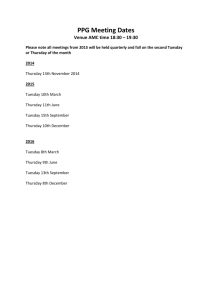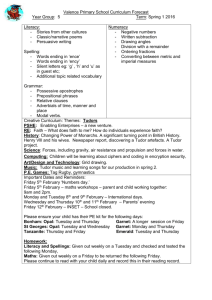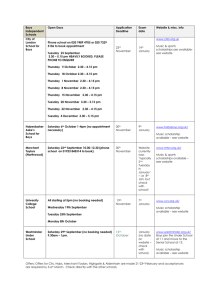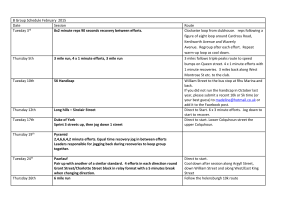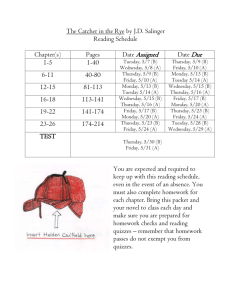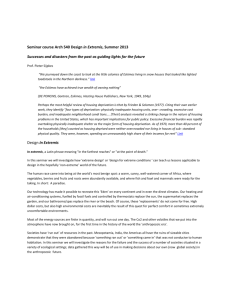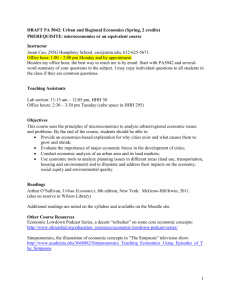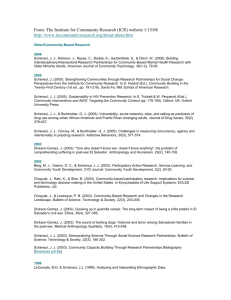Thursday, Feb 7 - Syracuse University
advertisement
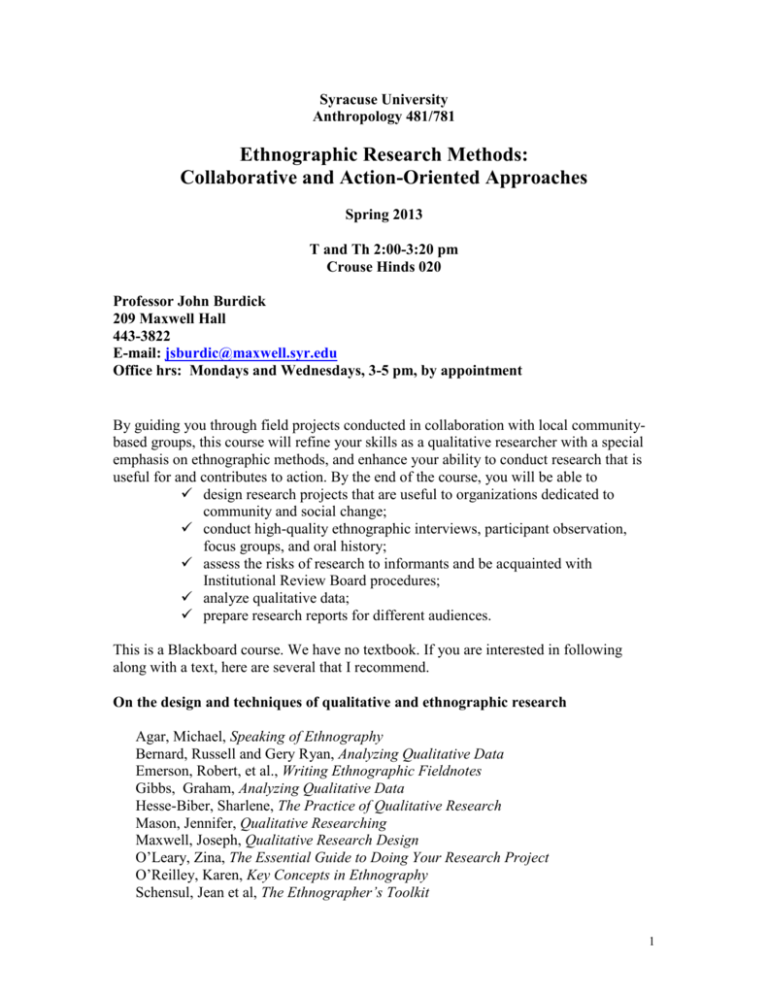
Syracuse University Anthropology 481/781 Ethnographic Research Methods: Collaborative and Action-Oriented Approaches Spring 2013 T and Th 2:00-3:20 pm Crouse Hinds 020 Professor John Burdick 209 Maxwell Hall 443-3822 E-mail: jsburdic@maxwell.syr.edu Office hrs: Mondays and Wednesdays, 3-5 pm, by appointment By guiding you through field projects conducted in collaboration with local communitybased groups, this course will refine your skills as a qualitative researcher with a special emphasis on ethnographic methods, and enhance your ability to conduct research that is useful for and contributes to action. By the end of the course, you will be able to design research projects that are useful to organizations dedicated to community and social change; conduct high-quality ethnographic interviews, participant observation, focus groups, and oral history; assess the risks of research to informants and be acquainted with Institutional Review Board procedures; analyze qualitative data; prepare research reports for different audiences. This is a Blackboard course. We have no textbook. If you are interested in following along with a text, here are several that I recommend. On the design and techniques of qualitative and ethnographic research Agar, Michael, Speaking of Ethnography Bernard, Russell and Gery Ryan, Analyzing Qualitative Data Emerson, Robert, et al., Writing Ethnographic Fieldnotes Gibbs, Graham, Analyzing Qualitative Data Hesse-Biber, Sharlene, The Practice of Qualitative Research Mason, Jennifer, Qualitative Researching Maxwell, Joseph, Qualitative Research Design O’Leary, Zina, The Essential Guide to Doing Your Research Project O’Reilley, Karen, Key Concepts in Ethnography Schensul, Jean et al, The Ethnographer’s Toolkit 1 On collaborative and action-oriented research: Davydd Greenwood and Levin, Action Research Charles Hale, ed., Engaging Contradictions Danny Murphy et al, Doing Community-Based Research Sanford, Victoria and Asale Angel-Ajani, eds. Engaged Observer: Anthropology, Advocacy and Activism Richard Sclove, ed, Community-Based Research in the United States Stoecker, Randy, Research Methods for Community Change Kerry Strand et al, Community-Based Research and Higher education Wali, Alaka. 2006. Collaborative Research: A Practical Guide, http://archive.fieldmuseum.org/par/ Williamson, Andy and Ruth De Souza, Researching with Communities THE FIRST 4 WEEKS Your work in this course depends on you connecting with an organization. Your research will be a contribution to this group; hence the need to move promptly to choose which group this will be, and enter soon into contact with it. Here is the timetable. 1) Friday, January 18. By this coming Friday I expect you to have decided which three (3) projects you are most interested in. Please e-mail me by 9 pm Friday, January 18 to tell me what they are. Please rank the three projects. For each project, write a few lines explaining what in your background, values, experience, skill-set, major, etc. has led you to be interested in the project. Please note: you may undertake a project with a group or organization that is not on this list, but only according to the rules stated under item #10 on the list of projects. 2) Sunday, January 20: By the end of the day I will have reviewed and collated everyone’s preferences and will send you a message letting you know which project you’ll be working on. It is important to have all of you engaged evenly across projects. If there is another student working with you, or on a closely related project, I will tell you who that student is. 3) Tuesday, January 22 By the end of the day you must have contacted the group’s contact person (identified on the project list) and set up a meeting. That meeting must take place no later than Wednesday, January 30 (the sooner the better). It is very important that you do not rely on e-mail alone to arrange this meeting. Lesson #1 of working with community-based groups is that you need to accompany any and all e-mail communication with a phone call -- usually more than one! 4) Wednesday, January 30. By this date you must have met face-to-face with your contact person for at least 40-60 minutes. If you are working on a project with another student, the two of you should attend the meeting together. In this meeting, you must accomplish the following: 2 a. Gather basic information about the organization (history, member-base, key struggles, etc.), orally and/or through brochures and other materials; b. Get clearer what you will be investigating. You should think through ways of making the questions more concrete, as per the readings and discussions in class. Engage your contact person in a conversation about how the questions might be made more concrete. c. Clarify to the community contact your overall work calendar/schedule, and the weekly time commitment you are making (average 4-5 hours/wk); d. Discuss the kind of support you hope to receive from the organization (e.g., having someone to introduce you to key informants, someone to take you around the neighborhood, share data with you, etc.); e. Explain that you will provide the organization with a 5-6 page work plan no later than Tuesday, February 12th. That plan will be informed by coursework, preliminary site visits and conversations. It may also be refined afterward by feedback from your field contact person. If your contact person wishes to see a preliminary work plan before February 12th, you may send one but emphasize that the plan is provisional until you complete the full-fledged plan by February 12th. 5) February 5. On this date an ungraded 4-page “pre-design” is due in class. This report is NOT a research design; it is your initial proposal for research. In this paper you a. describe the group you will be working with (brief history, number of people involved, objectives); b. describe the problem faced by the group which has generated issues to be investigated; c. describe in as operational a way as you can the research question(s) you will be investigating, and distinguish the core question from the subquestions. d. comment on possible issues/tensions having to do with your role as actionoriented researcher, and what biases may be active on the side of the organization. 6) February 12th. By this date you must have completed your research design & proposal. This is a 5-6-page paper (given both to me and the organization) in which you a) Compress the information conveyed in assignment #1 about objective, question and sub-questions; b) Identify the key populations you plan to investigate and why -- in terms of the characteristics they possess that are relevant to the research questions; c) Explain how these populations are bounded by geography, group or organizational membership, etc., and any limits on feasibility or access you may face; d) Identify and explain the procedures you intend to follow to draw samples from these populations; 3 e) Articulate in the form of one or more preliminary hunches what would constitute data relevant to your research question; f) Identify and explain the function and appropriateness of the different data collection methods you intend to use (you should have at least two methods); g) Set forth a data collection schedule and, if appropriate, include a statement of a division of labor among individuals collaborating on the project. COURSE REQUIREMENTS 1. Class participation…………………...…………………………….…….…10% This is a practice-oriented course designed to help you acquire, develop, and refine your skills as a researcher. Class time is devoted to a mix of practical exercises (in-class observations, interviews, focus groups, auto-ethnographic writing exercises, etc.) and discussion of readings. Some days we will spend more time on exercises; some more on readings. You need to come to class ready to participate both in classroom exercises and discussion. I pay close attention to the frequency and quality of your participation. 2. Reading responses………………………..………………………………….10% You will post a response to readings once per week on the Blackboard site. On the second day of class (Jan 17), I will divide you into two groups. Group A will be responsible throughout the semester for sending posts by 10:00 pm Monday nights about the readings assigned for Tuesday; group B will be responsible throughout the semester for sending posts by 10:00 pm on Wednesday nights, about the readings assigned for Thursday. Although you only post once per week, I expect you to read all of both sets of assigned readings every week. When you post, you will send to the Blackboard Discussion site a message of at least 200 words (run a word count please) in which you respond to the reading. This will focus you on key issues in advance, prime the pump for class discussion, allow you to see how your classmates think, and give me a feel for what is, and is not, making sense to you. Although I do not always respond to your posts, I read them all carefully. What is a reading response? By 10:00 pm the night before class, I expect you to post to the Blackboard Discussion a message of at least 200 words in which you do (at least) the following: 1) 2) 3) Comment on how the reading was significant/useful – state one or two things, for example, that you learned from it; for example, you may want to draw a connection between the reading and something we have done in class, or something you are experiencing in the field; If you found anything puzzling or confusing in the reading, say what it was; This is important: state a question (or questions) the reading leaves you with, and that you think might be useful for the class to discuss. We cannot always get to all questions in class discussions, but I want to know what your questions are. 4 Note: In each post, you must comment on at least two of the assigned readings. You may comment on them one by one, and/or by commenting on points of overlap or difference between them. Also; I occasionally substitute new readings for those on the syllabus. The readings posted on Blackboard take precedence over what appears on the syllabus. You are responsible for reading posted articles, even when they differ from what appears on the syllabus. How will my responses be evaluated? I do not grade individual posts. I expect you to post 11 times over the course of the semester. Your grade on the posts will be determined as follows: to be counted as a “post”, the text you send should be about 250 -300 words (run a Word count) 11 posts............................................................................................................................A 10 posts........................................................................................................................... A9 posts..............................................................................................................................B+ 8 posts...............................................................................................................................B 7 posts...............................................................................................................................B6 posts............................................................................................................................ C+ 5 posts ..............................................................................................................................C 4 posts….………………………………..…………………… ………………………...C3 posts…….……………………………………………………………………………..D Fewer than 3 posts………………………………………………………………………F 3. Field journal…………………………………...……………………………..15% I expect you to spend about 4 hours of field time every week and I expect you to write an average of at least two (2) pages of double-spaced field notes for every week you are in the field. (Graduate students must write at least three (3) pages per week). Please write your field notes digitally, for ease of access, and to facilitate coding and analysis later on. I expect you to write these notes every week between February 11th and April 16th (with one week off for spring break) for a minimum of 16-18 pages of notes overall. Students often find that they end up writing more than this; indeed, it is usually a good idea to do so. I will look at your field journal three times over the course of the term, to make sure you are keeping up with it. I will not grade individual entries in the journal; however, I will grade the overall journal at the end of the term based upon the care, seriousness, upto-datedness, and volume of writing that the journal exhibits. For example, a journal will be graded down if its writer did not keep it up to date, did not write enough, etc. The check-in dates are Feb 26, March 26, and April 16. 5 What should you write in my field journal? Field notes are generally of three kinds: primarily descriptive notes, analytical memos, and extended personal reflections. Certainly these can merge into each other, but you will discover that it is useful for purposes of method and later analysis to distinguish them as you write. Thus, as you begin an entry, it makes sense to pause for a moment, and give the note a heading, or otherwise identify it for yourself as belonging to one of these types of notes. (You may also discover other categories of notes; that is fine, but please let me know what they are). For this course, I am not asking you to keep three separate field journals, though some researchers do this—that is, they keep a separate journal for the three types of notes. I am just asking for a single Word document, in which you identify what kind of note you are writing. We will talk more in class about the three kinds of notes, but briefly, they are: Descriptive notes: Overall, at least 50-60% of your notes should be of this kind. In this kind of entry, your main goal is to provide yourself with detailed, sensory, experiencenear descriptions of stuff you experienced, saw, witnessed, heard, and talked about that is pertinent to your research question and project. While these entries are naturally filtered through various interpretive lenses, it is important for you to develop the skill of providing yourself with notes that are not themselves already “fully figured out,” fully digested, analyzed and interpreted. We will be engaging in classroom exercises to refine your skill in writing descriptive field notes, but your main development of this skill will come from keeping up your field journal on regular basis. The key for this kind of note is that you don’t have to “understand” everything you are writing. It is important not to let more than 1 day transpire between the time you are in the field, and the time you write your notes. Indeed, it is ideal that you write them on the same day (though I know this is sometimes hard to do). Analytical memos: What you seek to do in an analytical memo is to reflect in a more focused way on possible connections, patterns, and interpretations you are having of the stuff you are registering in your descriptive notes. Roughly 20% of your notes may be of this kind, but you do not have to do this kind of writing every time. Analytical memos get you into the groove of generating ideas for how to code your material later on, when you turn to more systematic analysis. While it is a good idea to start writing analytical memos while still in the field, it is also important to wait a few weeks before you plunge into writing them – let yourself get “marinated” first for a while in the field, before trying to analyze it. Once you do start writing analytical memos, it is crucial not to get carried away and let them crowd out your descriptive notes. You can easily get swept away by the beauty and symmetry of your analytical memos. Beware of becoming overcommitted to your own analyses at this stage. This kind of note must be in the spirit of brainstorming, trying out ideas, developing hunches, playing with possibilities. Extended personal reflections: It is important to take time in your notes, when you feel it is helpful and necessary, to reflect on how you are feeling personally about what you are doing and finding, about ethical and political issues, and about any project-related doubts, fears, worries, obsessions, etc. I recommend writing about 20% of your notes this way. This will allow you to work through concerns, articulate issues that you may want to bring to my attention of that of the class, etc. 6 4. Written exercises Preliminary “pre-design” plan, due Feb 5.….…….………….………………..not graded Research design, due Feb 12 ……..……………………………………..……....….….7% Observation report, due Feb 19...………………………….…………………….....…..7% Domain interview, due March 5………………………..…..………...……..…………7% IRB report, due March 19………………………..….…………………........……..…..7% Coding report, due April 9……….……..…...….….…………….……….................…7% 4. In-class presentation.……..…………. …………………………………....….7% On either April 18, 23, 25, or 30 you will make a 10-minute presentation on your project, followed by discussion. Detailed instructions for how to organize the presentation will be given later in the term. 5. Final report……….……………….…….……….…................………,,…….......17% Your final paper will report the findings/results of your semester-long project. Undergraduates must write a report of 12-14 pages; graduate students must write a paper of 14-18 pages. The report should be in a style that is suitable for your organizational audience. The report should include the following: a) statement of the research context; b) the method you used, and why; c) your principal findings and your interpretation of findings; e) a discussion of ethical and/or political issues raised through the process; f) suggestions about follow-up, dissemination of findings, and recommendations for action. In some cases, you may elect to prepare two documents: the report, and some other format of presentation (list of recommendations, exhibit, video, etc.) that is aimed primarily at the organizational audience. You will be receiving fuller instructions on this report later in the term. Due Tuesday, May 7 SPECIAL NOTES A note on time commitment This course involves a heavy time commitment. Anthropological research requires time in the field. Equally important, the course involves you in organizations beyond the academy’s walls: your time commitment sends the message that you are serious about the project. You should plan to be in the field (visiting the organization’s office, setting up meetings, traveling to and from research sites, observing, interviewing, and note-taking) on average about 4 hours per week. There will be weeks when you put in less than that, and weeks that you put in more; but that ought to be the average target. Every week that you are in the field I also expect you to devote at least one additional hour to writing field notes (see above). These are time commitments over and beyond the time required to prepare for class sessions and complete the assignments. 7 A note on your budget I will reimburse each of you up to $75 for expenses connected to your project. Reimbursable expenses include (for example): meals with informants (meeting for lunch/coffee, etc.); batteries and tapes for tape recorders; notebooks and writing instruments; film; bus fares; driving fuel costs; food for focus groups; Xeroxing expenses for flyers, announcements; gifts to informants; software relevant to the project; pertinent books. To be reimbursed, please keep your receipts, and submit them to me by Thursday, March 28. When you do so, I will need the following information all at the same time: 1. Your name, SUID and complete mailing address; 2. Brief description of why the expenditures were made and how it pertains to University business (the completion of the course); 3. Itemized, dated receipts for the purchases - the receipts must be taped in date order on paper with your name & SUID on top of each page; 4. If you purchased equipment, the equipment is the property of the University (A&S) and must be given to me at the end of the class so I can bring it over the A&S Dean’s office. 5. total amount you are asking to be reimbursed; 6. If you are employed by the University, you will need to sign an Employee Expense Voucher, by stopping by the office (209 Maxwell Hall) You will receive your reimbursement check by late April. A note on recording interviews and verbal notes There are several ways to record. 1) Borrow a digital recorder from Learning Environments at Newhouse II; 2) use the record function of your laptop; 3) use a digital recorder your own (these are very useful to have); 4) borrow one from a friend, acquaintance, or classmate A note on student papers from prior years Toward the end of the term, I will make available to you papers by students from prior years, as we turn to analysis and interpretation. Look for it! 8 Part 1: POSITIONING RESEARCH Tuesday, Jan 15 Introduction Thursday, Jan 17 What is “engaged” research? Course syllabus and list of projects (please read carefully) Setha Low and Sally Merry, “Engaged Anthropology: Diversity and Dilemmas”, 203-214 (2010) [The “Comments: section is optional] Philip Nyden, “University-Community Collaborative Research: Adding Chairs at the Research Table” Tuesday, Jan 22 What do you personally bring to this study? Joseph Maxwell, “Purposes: Why Are You Doing this Study?” _____________, “Experiential Knowledge” Veronica Crossa, “Relational positionality: Conceptualizing research, power, and the everyday politics of neoliberalization in Mexico City” Part 2: BASIC RESEARCH DESIGN Thursday, January 24 What is a core research question? Kerry Strand, et al, “Getting Started: Identifying a Research Question” Jean Schensul, “Designing and Conducting Ethnographic Research” Zina O’Leary, “From Problems to Research Questions” Joseph Maxwell, “Research Questions: What Do You Want to Understand?” John Burdick, “Clarifying Research Questions” 9 Tuesday, January 29 Developing relations in the field Carolyn Wanat, “Getting Past the Gatekeepers” Samuel Martinez, “Making Violence Visible” Thursday, January 31 What are sub-questions? What is “research design”? Schensul, “Elaborating Research Questions” Schensul, “Overview of Research Design” Tuesday, Feb 5 What is a “population”, and how do I decide which ones to focus on? PRE-DESIGN DUE Schensul, Jean and Margaret LeCompte, “Selecting Populations and Units of Analysis” Thursday, Feb 7 How do I recruit and sample participants for this study? How do I decide which research-gathering techniques to use? Jean Schensul et al, “Ethnographic Sampling” Kerry Strand et al, “Collecting the Data” Annette Brunovskis, “Untold Stories” Schensul and LeCompte, “Data Collection Techniques” 10 PART 3: OBSERVATION AND INTERVIEWING Tuesday, Feb 12 Observation, 1 RESEARCH DESIGN DUE Robert Emerson et al, Writing Ethnographic Fieldnotes, 17-65 James Spradley, Participant Observation, 53-80 Gibbs, “Writing”, 24-37 Sarah Pink, “Re-sensing participant observation: sensory emplaced learning” Thursday, Feb 14 Observation, 2 Emerson et al, Writing Ethnographic Fieldnotes, 66-141 Tuesday, Feb 19 Interviewing about specific domains OBSERVATION REPORT DUE Hesse-Biber and Leavy, “Designing an in-depth interview study” James Spradley, “Asking Descriptive Questions” Sarah Pink, “Articulating Emplaced Knowledge: Understanding Sensory Experiences through Interviews” Thursday, February 21 Issues of power in interviewing Sand and Krumer-Nevo, “Interview Shocks and Shockwaves” Rice, Gareth. 2010. Reflections on interviewing elites. Area 42, 70-75 Miller and Glassner, “The ‘inside’ and the ‘outside’” Hiller and DeLuzio, “The interviewee and the research interview” Tuesday, February 26 Using places, objects and photographs FIELD BOOK CHECK-IN #1 Sarah Pink, “Walking with video” Cohen and De Leon, “Object and Walking Probes” Katherin Fultz, “Collaborative Media Production and Antropología Comprometida” Castleden, Heather, Theresa Garvin, and Huu-ay-aht First Nation. “Modifying Photovoice for Community-Based Participatory Indigenous Research.” 11 PART 4: ETHICS AND POLITICS Thursday, February 28 Risks, benefits, and informed consent AAA, 1998 Code of Ethics, plus 2009 update Soyini Madison, 2012, “Methods and Ethics”, from Critical Ethnography, 127155 Soyini Madison, “Case 2: Secrets, Sexuality, and Oral History”, 155-160 Tuesday, March 5 Specific ethical dilemmas; the IRB process INTERVIEW ASSIGNMENT DUE Kathryn Blee and Tim Vining, 2010. “Risks and Ethics of Social Movement Research in a Changing Political Climate” Louisa Allen, “Caught in the Act” htthttp://www.aaanet.org/stmts/irb htmp://www.aaanet.org/committees/ethics/ethcode.htm http://www.aaanet.org/stmts/irb.htm http://www.aaanet.org/committees/ethics/bp.htm Thursday, March 7 Collaborative, participatory and activist models of research Shirley Suet-ling Tang, 2008. “Community-Centered Research as Knowledge/Capacity Building in Immigrant and Refugee Communities”, Engaging Contradictions One on PAR Shannon Speed in Engaging Contradictions (2008) Charles Hale, “In Praise of Reckless Minds” (2007) 12 PART 5: SPECIAL DATA-GATHERING TECHNIQUES Tuesday, March 19 Chronologically deep interviews IRB REPORT DUE Sean Field, “Oral History Methodology” 2 of the following: Alicia Rouverol, “Collaborative oral history in a correctional setting: Promise and pitfalls” Jocelyn Vargas, “Afro-Puerto Rican Oral Histories” Wendy Rickard, “Collaborating with sex workers in oral history” Rachel Slater, “Using life histories to explore change” Papa and Lassiter 2003 Campbell and Lassiter 2010 Thursday, March 21 Focus group interviews Pranee Liamputtong, Focus Groups: Principles and Practice (2011) Tuesday, March 26 Auto-ethnography FIELD BOOK CHECK-IN #2 Heewon Chang, Autoethnography as method (selections) Further reading: Computer-mediated social relations Sarah Pink, 2012a. “The Digital Places of Everyday Life: Thinking About Activism and the Internet” _________, 2012b. “Visual ethnography and the internet: visuality, virtuality and the spatial turn” Anne Beaulieu, 2011 “From co-location to co-presence” ____________ and Adolfo Estallela, 2012 “Rethinking Research Ethics for Mediated Settings” James Dickman, 2010 “Social Interactions on Skype” 13 PART 6: ANALYSIS AND REPRESENTATION Thursday, March 28 Beginning the process Gibbs, “The Nature of Qualitative Analysis”, _____, “Data Preparation” McClellan et al, “Beyond the Qualitative Interview” Tuesday, April 2 Generating and using categories: codes and key events Emerson et al, “Processing fieldnotes” Gibbs, “Thematic Coding and Categorizing” Thursday, April 4 Finding pattern and significance Gibbs, “Analyzing Biographies and Narratives” ____, “Comparative Analysis” Kearney et al, “Salvaging Self” Tuesday, April 9 Developing interpretations CODING REPORT DUE Soyini Madison, “Case 3: Community Theatre: Conflicts and Organization,” 81-92 Dodson and Schmarlzbauer, “Poor Mothers and Habits of Hiding” Daniel Kerr, “’We Know What the Problem Is” Further reading: using qualitative data management software Gibbs, “Getting started with computer-assisted qualitative data analysis” _____, “Searching and Other Analytic Activities Using Software” Thursday, April 11 Validating and triangulating findings and interpretations Joseph Maxwell, “Validity: How Might You Be Wrong?” J. Schensul, “Validity and Reliability” Gibbs, “Analytic Quality and Ethics” Tuesday, April 16 Representing findings and interpretations FIELDBOOK CHECK-IN #3 Soyini Madison, “Case 1: Local Activism in West Africa”, 147-155 Kerry Strand et al, “Reporting the Results” Emerson, Robert et al, “Writing an Ethnography” Coffey and Atkinson, “Writing and Representation” Gibbs, “Putting it all together” 14 PART 7: PRESENTATIONS Thursday, April 18 STUDENT PRESENTATIONS Tuesday, April 23 STUDENT PRESENTATIONS Thursday, April 25 STUDENT PRESENTATIONS Tuesday, April 30 STUDENT PRESENTATIONS 15
